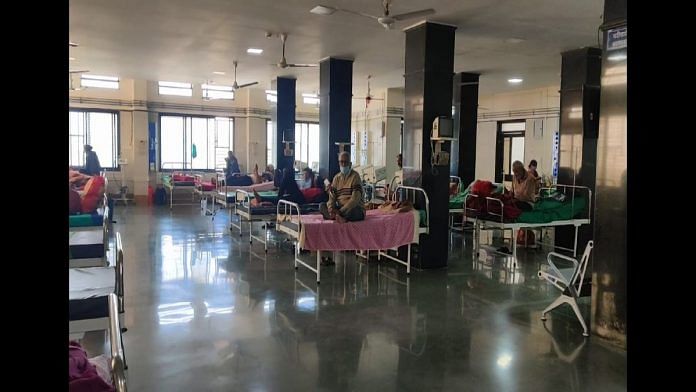Amravati (Maharashtra): Months before the deadly second wave of the Covid-19 pandemic convulsed the country, it was Amravati district, in Maharashtra’s Vidarbha region, that first showed signs of a surge driven by what looked like a new variant. However, the Omicron variant-driven third wave seems to be giving it respite so far.
In February 2021, virologists suspected that a new, more virulent, variant of the SARS-CoV-2 virus was in circulation in Amravati district. The variant, which came to be known as Delta, eventually drove the pandemic’s second wave across India.
But first, it was Amravati that bore its full weight, and the district struggled with a high Covid caseload.
Almost a year later, as many districts are grappling with the third wave of the pandemic, Amravati, 700 km from state capital Mumbai, is relatively calm. Since December, 25 cases of the new variant have been recorded here. This is out of a random pool of positive samples sent for genome sequencing.
The number of active cases is also far lower than in the first two waves.
But the number of new cases is fast on the rise and authorities are being cautious, assuming that the peak is yet to come. At the beginning of the third wave, on 1 January, Amravati’s daily Covid caseload was 9. It jumped to 397 on 19 January.
As of 19 January, Amravati district had 1,800 active cases.
The administration isn’t taking chances. Healthcare facilities have been fast upgraded, and measures are being taken to vaccinate more people, as Amravati lags behind the rest of Maharashtra on this count.
Also read: How winter session of legislature, political weddings turned Covid ‘superspreaders’ in Mumbai
High caseload in first two waves
Yashomati Thakur, guardian minister for Amravati district and Women and Child Development Minister in the Uddhav Thackeray-led Maharashtra cabinet, told ThePrint, “We have been cautious about it. We have to be very careful as we don’t want cases to rise. So, we are taking precautions and making people aware of it too.”
According to data from doctors at the Amravati District Hospital, during the first wave in September 2020, the district saw a peak of over 7,000 cases a day, while active cases hovered over 5,000. In May 2021, during the peak of the second wave, the daily caseload jumped to as high as 27,000 — the highest in Amravati so far.
District civil surgeon Shamsundar Nikam said it was unfortunate that the Delta variant had emerged in Amravati. “But, since then, we have done a lot of ground preparations. We increased our contact tracing and testing, and infrastructure-wise, did a lot of upgradation,” he added.
In anticipation of the third wave, the Amravati district hospital administration took various steps. Dr Suraj Dharpawar, who was at the forefront of tackling the pandemic since the very beginning, told ThePrint that preparation for the health infrastructure to cater to the third wave was done assuming that the number of cases would be 1.5 times more than the second wave.
Initially, Amravati didn’t have any oxygen plants, but it now has 16 PSA (Pressure Swing Adsorption) oxygen generating plants, out of which 12 are functional and work on the rest is under way.
After the second wave, the district also added five liquid medical oxygen (LMO) storage tanks, while 16 more are in the pipeline, Dharpawar informed.
“The planning for this started from 20 July 2021. During the second wave, all our beds were full and we planned for additional oxygen and ventilator beds. Fortunately, this time only 10 per cent of the 400 general beds in the hospital are full,” he said.
The district has also been trying to ramp up vaccinations, for Amravati currently fares below the state average.
According to state health department data, till 30 December 2021, 81 per cent of the population in Amravati had taken the first dose of the vaccine, when the state average was 87 per cent. The state average for the population covered with two doses was 57 per cent, while for Amravati it was just 43.1 percent.
Guardian minister Yashomati Thakur, who is from the Congress, attributed the lacklustre vaccination to a delay in getting adequate stocks of vaccines.
“Among my patients, those requiring oxygen are ones whose vaccination isn’t complete or who aren’t vaccinated at all,” said Dr Vishal Dande, nodal officer at the super speciality Covid hospital in Amravati.
Administration alert
Speaking to ThePrint, doctors at the Amravati District Hospital admitted that the entire administration had dropped the ball after the first wave started ebbing in September 2020. The testing in the district after September 2020 dropped to barely 100 a day from around 1,000 a day before.
“So, the identification of patients stopped and we even ran out of testing kits at one point,” said a doctor who did not wish to be named.
Dharpawar said that when the district eventually resumed aggressive testing in February and March 2021 in the teeth of the second wave, the positivity rate touched nearly 60 per cent at one point.
“Transmissibility and virulence are inversely proportional,” Dr Pramod Niravane, additional civil surgeon, Amravati District Hospital, said. “During Delta, there was higher virulence and hence patients were in serious condition, but this time around, transmissibility is higher.”
“However, we are much more prepared now. We have enough experience from the first and second waves,” said Niravane.
(Edited by Saikat Niyogi)
Also read: Why Covid variants seem to appear in Maharashtra first



